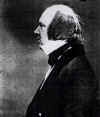|
1839 - Talbot and Daguerre |
|
The Discovery of Photography The year 1839 marks the start of photography, as we know it today. Both Daguerre (1787-1851) and Talbot (1800-1877) had been experimenting independently for several years on their different photographic processes when Daguerre announced his discovery to the world in Paris on 7 January 1839. This prompted William Henry Fox Talbot to display the results of his negative/positive process to the Royal Institution in London (the same organization as today presents the BBC Christmas Lectures) on 25 January 1839. He then presented a Paper to the Royal Society on 31 January 1839, describing his process as “photogenic drawing”. Talbot sent examples of his work in early February 1839 to Sir David Brewster, who was later to become the first President of the Photographic Society of Scotland (PSS) and an Honorary Member of Edinburgh Photographic Society (EPS). The announcements by Talbot and Daguerre were made about eighteen months into the reign of Queen Victoria, and about eighteen months before she married Prince Albert. Both Queen Victoria and Prince Albert became keen enthusiasts of photography and collectors of photographs. Prince Albert became the first Patron of PSS. He died in the year that EPS was established. |
|
Early Photography in Edinburgh The discovery of photography created immediate interest amongst the citizens of Edinburgh. In 1839, papers on the subject were read at Meetings of The Society of Arts for Scotland, and James Howie held a daguerreotype exhibition. Soon afterwards, he opened Scotland’s first daguerreotype studio at his premises in Princes Street. |
1839 - Exhibition |
|
Exhibition of Arts, Manufacturers The Exhibition of Arts, Manufacturers and Practical Science was held at Assembly Halls, George Street, from 24 Dec 1839 until 7 Jan 1840. Twenty photographs (or photogenic drawings) by Talbot were exhibited, together with a Photogenic Camera made by Mr Davidson, who would soon be making cameras for Robert Adamson. The Exhibition attracted over 50,000 visitors. [Larry L Schaaf: Studies in Photography 1998, p27] |
|
Question Photographs by Daguerre were also exhibited in Edinburgh in December 1839 [David Bruce]. Were these exhibited at the same exhibition? |
Other Early Edinburgh Photographers |
|
Thomas Davidson played a prominent part in the early development of photography in Edinburgh, both as an early photographer and as a maker of photographic equipment from 1839 onwards, including equipment for Hill & Adamson a few years later. Mungo Ponton reported to Edinburgh on some early discoveries in photography, from 1839 onwards. |
1843 - Hill & Adamson |
|
David Octavius Hill may have been introduced to the calotype process by his friend, Hugh Miller, before setting up in partnership with Robert Adamson who had recently set up a calotype business at Rock House, Edinburgh in 1843. Hugh Miller published an article on the calotype process in his paper, The Witness, on 12 July 1843. Hill & Adamson established their studio at Rock House, Calton Hill in 1843, and created over five thousand prints from their calotype negatives over the next four years. There work is well documented elsewhere, so I have made only passing reference to it on this web site. Several other professional photographers set up business in Princes Street in the 1840s. |
Photographic Societies |
1840sIn the early 1840s a group of amateur photographers, mainly from the legal profession, visited Sir David Brewster in St Andrews to discover how to use Talbot’s Calotype Process. They returned to Edinburgh, and, around 1843, formed The Edinburgh Calotype Club This was, perhaps, the earliest photographic society in the world. |
1850sIn 1851, the wet collodion process was announced. At that time photography was becoming more popular and more widely available. A few photographic societies were established in Britain. One of the first, in 1856 was Photographic Society of Scotland. |
1860sIn 1861, Edinburgh Photographic Society was established. Both the PSS and EPS held Annual Exhibitions. Early exhibitions attracted entries from some of the most renowned photographers in Britain. Both societies held meetings for their own members, and Popular Meetings which brought photography to the wider public in Edinburgh, and no doubt attracted a few more Members to the societies. Edinburgh Photographic Society offered practical meetings with less formality than PSS. Membership grew rapidly. The annual subscription was set at five shillings, and remained at that level for over thirty years. |



